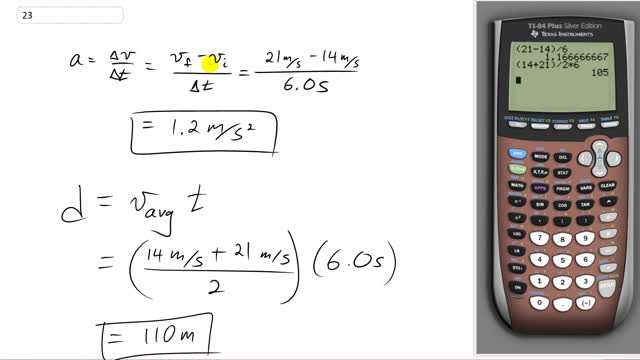
A car accelerates from 14 m/s to 21 m/s in 6.0 s. What was its acceleration? How far did it travel in this time? Assume constant acceleration.

In order to watch this solution you need to have a subscription.
This is Giancoli Answers with Mr. Dychko. Acceleration is the change in velocity over time so we have the final velocity minus initial velocity divided by the time it takes to make the change. So we have 21 meters per second final for the car minus its initial velocity of 14 meters per second divded by 6 seconds gives an acceleration of 1.2 meters per second squared. The distance that it travels during this time is its average velocity times time and the average is, you know, in the case where you have constant acceleration, you can just take the initial and the final and divide by 2. So we have 14 meters per second plus 21 meters per second divided by 2 times by 6 seconds gives us a 110 meters when you round it to two significant figures.
I may be missing something, but shouldn't those calculations come out to 105m
Hi Anne-Lelin,
Thanks for your comment, and you're quite right that . would be the correct answer in a mathematics class. However, since this is physics, we need to account for significant figures since the values are not infinitely precise as they would be in math class. The sum of the two values in the numerator will be precise to the "ones" place, giving , which has two significant figures. This is then divided by a "mathematical factor" . I call this a "mathematical factor" since it isn't measured, so it does in fact have infinite precision. This results in , which has only two significant figures. We won't round it yet, however, since rounding happens only in the final answer, and we'll just keep the fact of 2 significant figures in our mind. Rounding now would be called an "intermediate rounding error" since this is an intermediate calculation done in the process of getting the final answer. The next calculation is , as you mentioned. And here's the real point: should have only 2 significant figures, which rounds to .
I know that's a long answer, but hopefully it helps illustrate the process of considering significant figures in physics calculations.
All the best with your studies,
Mr. Dychko
hi why in the bottom equation can you just say that average velocity is the two terms summed and divided by two if average velocity was previously defined as displacement over time? This seems like the equation for speed
Hi umajacobshome, thanks for the question. Average velocity is indeed defined as displacement over time, as you say. There is a special case though when acceleration is constant, in that the average velocity in this case can also be calculated as the sum of the initial and final velocities divided by 2. Written as an equation, that is to say in the special case when acceleration doesn't change.
Hope this helps,
Mr. Dychko